Draw a diagram of a right angled isoscels prism which is used to make an inverted image erect.
To solve the question of drawing a diagram of a right-angled isosceles prism that makes an inverted image erect, we can follow these steps:
1. Draw the Prism: Start by sketching a right-angled isosceles triangle. Label the vertices as A, B, and C, where A and B are the points forming the right angle, and C is the apex opposite the right angle.
2. Label the Base: Identify the base of the prism, which is the side opposite the right angle. This will be the side AC or BC, depending on your orientation.
3. Draw the Object: Draw a vertical line segment labeled AB, which represents the object. Place this line outside the prism, to the left of the prism.
4. Draw Incident Rays: From the top and bottom of the object (points A and B), draw two straight lines (incident rays) towards the prism. These lines should strike the surface of the prism at an angle.
5. Refraction at the First Surface: Indicate the bending of the rays as they enter the prism. The rays will bend towards the base of the prism (point C) due to refraction.
6. Total Internal Reflection: At the base of the prism (side AC or BC), show that the rays reflect back into the prism. This is due to total internal reflection, which occurs when the angle of incidence is greater than the critical angle.
7. Refraction at the Second Surface: Draw the reflected rays as they exit the prism through the second surface (the side opposite the base). Indicate that these rays bend again as they exit the prism.
8. Draw the Erect Image: Extend the refracted rays beyond the prism to show where they appear to diverge from a point. Label this point as A'B', which represents the erect image of the object.
9. Label the Diagram: Clearly label all parts of the diagram, including the object (AB), the image (A'B'), the prism (ABC), and the incident and refracted rays.
Final Diagram:
- The final diagram should clearly show the right-angled isosceles prism with the object on one side and the erect image on the other side, along with the paths of the incident and refracted rays.
- The final diagram should clearly show the right-angled isosceles prism with the object on one side and the erect image on the other side, along with the paths of the incident and refracted rays.
Topper's Solved these Questions
- REFRACTION OF LIGHT AT PLANE SURFACESBOOK - ICSECHAPTER - REFRACTION OF LIGHT AT PLANE SURFACESEXERCISE - EXERCISE-4(D) MULTIPLE CHOICE TYPE
3 Videos
- REFRACTION OF LIGHT AT PLANE SURFACESBOOK - ICSECHAPTER - REFRACTION OF LIGHT AT PLANE SURFACESEXERCISE - EXERCISE-4(C) NUMERICALS
3 Videos
- REFRACTION OF LIGHTBOOK - ICSECHAPTER - REFRACTION OF LIGHTEXERCISE - DIAGRAM BASED MCQ:
5 Videos
- REFRACTION THROUGH A LENS BOOK - ICSECHAPTER - REFRACTION THROUGH A LENS EXERCISE - EXERCISE-5(D) (MULTIPLE CHOICE TYPE)
2 Videos
Similar Questions
Show with the aid of a ray diagram, how a right angled isosceles prism can be used to invert the rays. (a) How sould the rays fall on the prism ?
(b) Which phenomenon is responsible for this action of prism? (c) What is the nature of the image in relation to the object ?
View SolutionDraw a ray diagram to show a right angled isosceles prism may be used to ''bend the path of light rays by 90∘.
Write the necessary condition in terms of the refractive index of the material of this prism for the ray to bend to 90∘.
View Solution
Knowledge Check
A total reflecting right angled isosceles prism can be used to deviate a ray of light through :
A30∘B60∘C75∘D90∘
Draw a right angled isosceles triangle whose hypotenuse is 5.2 cm long.
View SolutionA ray of light XY passes through a right angled isosceles prism as shown below.
Name the instrument where this action of prism is put into use.
View SolutionA ray of light XY passes through a right angled isosceles prism as shown alongside.
Name the instrument where this action of prism is put into use.
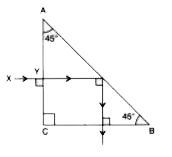
View Solution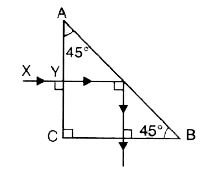
A ray of light XY passes through a right angled isosceles prism as shown alongside Figure.
(a) What is the angle through which the incident ray deviates and emerges out of the prism?
9b) Name the instrument where this action of prism is put into use.
(c) Which prism surface will behave as a mirror ?
View SolutionA ray of light XY passes through a right angled isosceles prism as shown alongside.
What is the angle through which the incident ray deviates and emerges out of the prism ?
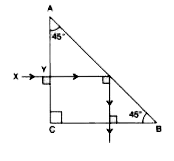
View SolutionA ray of light XY passes through a right angled isosceles prism as shown below.
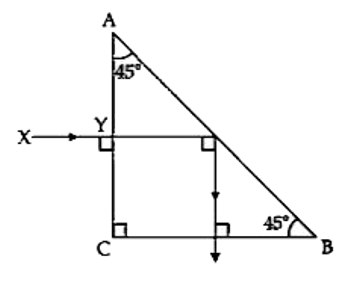
What is the angle through which the incident ray deviates and emerges out of the prism?
View SolutionA ray of light XY passes through a right angled isosceles prism as shown below:
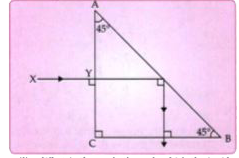
Which prism surface will behave as a mirror ?
View Solution
